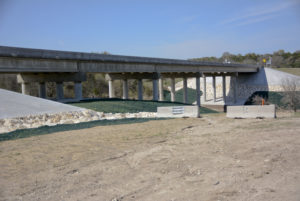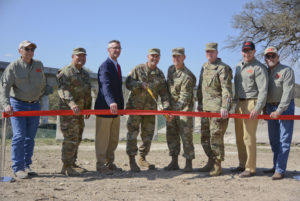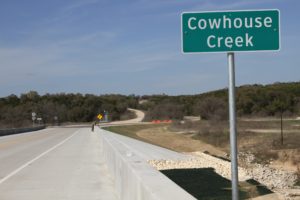FORT HOOD, Texas — The Directorate of Public Works hosted the Old Georgetown Road Bridge ribbon cutting ceremony March 22.
The completed construction of this bridge will improve Soldier and unit safety while training on the west side of post and provide an all-weather safe route for civilian traffic traveling to and from North Fort Hood.
“This bridge is going to save lives,” Brian Dosa, Fort Hood director of Public Works said. “It was a very unsafe situation for our Soldiers, units out training and frankly, for anyone who was in a vehicle that was trying to drive across Fort Hood.”
The 450-foot bridge replaced an old condemned bridge and a low-water crossing.
“We are very excited that we have replaced and corrected that unsafe deficiency with the bridge,” Dosa added.
The $9.7 million highway bridge was recently completed at “Jackson’s Crossing” where Georgetown Road crosses the Cowhouse Creek. Cowhouse Creek is the largest water conveyance on Fort Hood.
“This bridge goes a long way with reducing major hydrology hazards and brings peace of mind,” III Corps and Fort Hood Deputy Commander Maj. Gen. JT Thomson said. “But even with this bridge, we must be aware of flash-flooding and the hazards we have in training areas with other numerous creeks and low water crossings.”
The Directorate of Public Works at Fort Hood partnered with the United States Army Corps of Engineers, Fort Worth Division, to complete the 14-month long project.
“The bridge was built to be able to handle a 100-ton vehicle; an Abrams tank is 70 tons,” Dosa said. “We can handle everything that the Army has across this bridge.”
Dosa said the next project will be the Turkey Run low water crossing.
Other measures have been taken across the installation, in the meantime, to improve safety at low water crossings. Six United States geologic stream gauges have been installed across the installation. One of them is at the Old Georgetown Bridge.
“The information from the stream gauges is sent to a satellite and allows for better prediction of water flow and floods,” Dosa said. “Like the Amber-Alert, this technology enables us to be able to send out a message to inform locals of flooding at specific creeks and low water crossings.”
According to Dosa, the bridge is designed to handle certain types of storms like the 25-year flood.
“As engineers, it’s our responsibly to uphold the life, health and safety of the citizens of Fort Hood, Soldiers and Families of Fort hood,” Dosa said.



